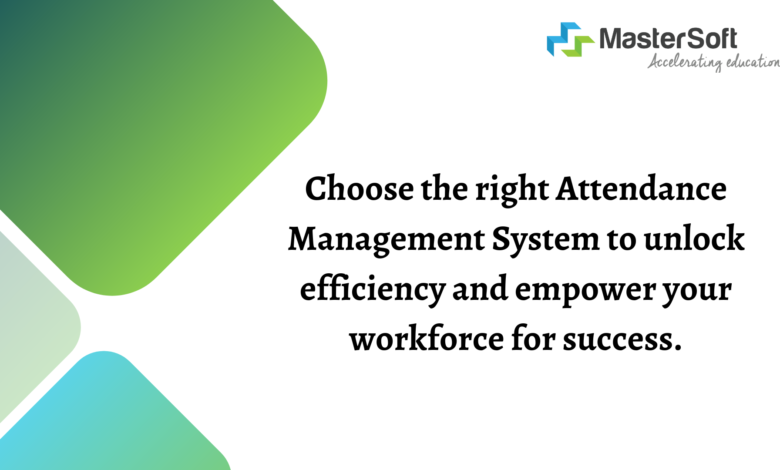Right Attendance Management System for Your Business

The Importance of Choosing the Right Attendance Management System
In today’s dynamic business landscape, where time is money and efficiency is key, the choice of an Attendance Management System (AMS) can make or break an organization’s success. A robust AMS not only tracks employee attendance but also streamlines processes, enhances productivity, and ensures compliance with labor regulations. This blog delves into the intricacies of selecting the perfect AMS tailored to your business needs.
Understanding Your Business Needs
Before embarking on the journey of selecting an AMS, it’s crucial to conduct a thorough analysis of your organization’s requirements. Consider factors such as company size, industry-specific regulations, workforce composition (e.g., full-time employees, part-time workers, remote staff), and operational workflows. Engage key stakeholders, including HR professionals, department heads, and IT personnel, to gather insights and ensure alignment with organizational goals and objectives.
Identifying Key Features and Functionalities
AMS come in various shapes and sizes, offering a plethora of features and functionalities to cater to diverse business needs. Common features include time tracking, scheduling, leave management, reporting, and integration capabilities. Identify the must-have features based on your business requirements, such as biometric authentication for enhanced security, mobile accessibility for remote workforce management, and customizable reporting for data-driven insights. Prioritize features that align with your organization’s goals and objectives to ensure optimal utilization of the AMS.
Evaluating Integration Capabilities
Seamless integration with existing systems is paramount to avoid siloed data and ensure operational efficiency. Assess the compatibility of the AMS with your existing Human Resource Management System (HRMS), payroll software, and other relevant applications. Look for AMS that offer robust Application Programming Interfaces (APIs) or pre-built integrations with popular software platforms. A tightly integrated ecosystem ensures smooth data flow, eliminates redundant data entry, and enhances overall workflow automation.
Assessing User-Friendliness and Accessibility
User adoption is key to the success of any AMS implementation. Opt for a user-friendly interface that simplifies the employee experience and reduces the learning curve. Conduct usability tests or pilot programs to gather feedback from end-users and identify areas for improvement. Consider factors such as accessibility options (e.g., mobile apps, web-based portals), multilingual support, and intuitive navigation to accommodate diverse user preferences and ensure widespread adoption across the organization.
Ensuring Data Security and Compliance
Protecting sensitive employee data is paramount in today’s regulatory landscape. Choose an AMS that employs robust security measures, such as data encryption, role-based access controls, and regular security audits. Ensure compliance with relevant regulations, such as the General Data Protection Regulation (GDPR), Fair Labor Standards Act (FLSA), and Health Insurance Portability and Accountability Act (HIPAA), to avoid legal repercussions and safeguard employee privacy. Partnering with a reputable vendor with a proven track record of compliance and data security is essential to mitigate risks and instill confidence in your AMS choice.
Considering Scalability and Growth Potential
As your business evolves and expands, so should your AMS. Evaluate the scalability and flexibility of the AMS to accommodate future growth and changing business needs. Consider factors such as the ability to handle increasing data volumes, support additional users or locations, and adapt to evolving regulatory requirements. A scalable AMS ensures long-term viability and minimizes the need for costly system upgrades or replacements down the line.
Evaluating Vendor Reputation and Support
Selecting a reliable vendor is crucial to ensure a smooth implementation process and ongoing support. Conduct thorough research on vendor reputation, including customer reviews, testimonials, and industry accolades. Evaluate the vendor’s track record of successful implementations, responsiveness to customer inquiries, and commitment to customer satisfaction. Engage with prospective vendors through product demonstrations, vendor assessments, and reference checks to gauge their suitability and establish a mutually beneficial partnership.
Calculating Return on Investment (ROI)
Investing in an AMS is a strategic decision that requires a comprehensive analysis of costs and benefits. Calculate the potential ROI by quantifying the tangible and intangible benefits of implementing the AMS. Tangible benefits may include time savings from automated processes, reduced administrative overhead, and lower compliance costs. Intangible benefits such as improved employee morale, enhanced decision-making capabilities, and increased operational efficiency should also be considered. Conduct a cost-benefit analysis to weigh the upfront investment against the long-term value proposition and make an informed decision that aligns with your organization’s financial objectives.
Conclusion: Making the Right Choice for Your Business
In conclusion, selecting the right Attendance Management System is a strategic imperative for businesses seeking to optimize workforce management, enhance productivity, and ensure compliance with labor regulations. By understanding your business needs, identifying key features, evaluating integration capabilities, ensuring data security and compliance, considering scalability, assessing vendor reputation, and calculating ROI, you can crack the code and choose an AMS that meets your organization’s unique requirements. Remember, the right AMS is not just a tool but a strategic asset that drives business success and empowers your workforce to achieve their full potential.
Read More Blog Here




